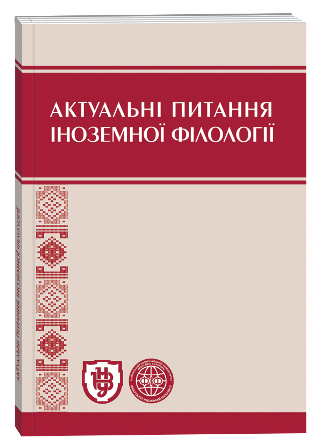FRAME “FEELING” IN FICTIONAL DISCOURSE (ON THE MATERIAL OF THE LITERARY WORK OF THE AUSTRIAN WRITER S. ZWEIG)
DOI:
https://doi.org/10.32782/2410-0927-2020-13-10Keywords:
frame, frame structures, terminal, terminal element, feeling, emotionAbstract
The article deals with the analysis of the frame structures denoting feelings in the literary discourse. The notions “frame” and “frame structure” have been viewed from different angles. Frames are qualified as cognitive formations, the component parts of which are the terminals and which are being realized in the discourse by means of the frame structures. The key constituents of the frame structures are the terminal elements which are directly related to the language realization of the terminals. The research has been carried out on the material of Stefan Zweig’s novel «Ungeduld des Herzens» («Beware of Pity», literally: «The Heart’s Impatience»)). In this literary work the frame structures have been analyzed, in which the terminal elements representing the frame “Feeling” portray personages’ emotional sphere and disclose their inner world. In the present research the structure of the frame “Feeling” has been described and its main terminals have been defined. This frame is considered as a mental formation based on the categorial knowledge of human feelings – the fact that people sense not with the mind but inwardly, “in the heart”, for instance fear, relief, joy, unconcern, uncertainty etc. On the basis of the dictionary definition the basic terminals of the frame «FEELING» («GEFÜHL») were determined: «Internal Aspiration» («seelische Regung»), «Sensation» («Empfindung»), «Mood» («Einstellung»), «Attitude to the World» («Haltung zur Welt»). Within the framework of the stated terminals the complex analysis of the lexical units denoting feelings of the literary characters of the novel “Ungeduld des Herzens” has been carried out, different nuances of their emotional experience and thoughts have been shown, the innermost dreams have been revealed and the most thinkable aspirations of human soul have been depicted. The analyzed frame structures give a key to understanding of heroes’ behavior and their motives, represent their feelings that incite them to reckless acts, both to feats and to evil deeds, portray passions which can become the cause of a failure as well as the basis for the beginning of the new relationships. The analysis of the text material has shown that the frame structures denoting emotions and feelings are an effective means in the representation of the inner world of the literary heroes as well as an efficient mechanism of the explication of the author’s pragmatics.
References
Charniak, E. 1977. “A Framed Painting: The Representation of a Common Sense Knowledge Fragment”. Cognitive Science 1: 355–394.
Dijk, T. A. van. 1977. “Semantic Macrostructures and Knowledge Frames in Discourse Comprehension”. Cognitive Processes in Comprehension, edited by M. A. Just , P. A. Carpenter, 3–32, Hillsdale.
Duden. 2001. Deutsches Universalwörterbuch. Mannheim, Leipzig, Wien, Zürich: Dudenverlag.
Fillmore, Ch. J. 1987. “A Private History of the Concept ‘Frame’”. Concepts of Case. Tübingen, 28–36.
Fillmore, Ch. J. 1986. “U”-Semantics, Second Round”. Quaderni di Semantica VII: 49–58.
Fillmore, J. 2003. Ch. Form and Meaning in Language: Papers on Semantic Roles. Stanford : CSLI Publications.
Goffman, E. 1974. Frame Analysis. An essay on the organization of experience. N.Y.
Hayes, P. 1980. “The Logic of Frames”. Frame Conceptions and Text Understanding 46–67.
Lakoff, G. 1987. Women, Fire and Dangerous Things: What Categories Reveal about the Mind. Chicago: University of Chicago Press.
Metzing, D. 1981. “Frame Representations and Lexical Semantics”. Words, Worlds, and Contexts. Berlin, 320–342.
Minsky, M. 1981. “A Framework for Representing Knowledge [Gekürzte und leicht veränderte Fassung von Minsky]”. Mind Design. Cambridge, 95–128.
Schank, R. C., Abelson, R. P. 1977. Scripts, Plans, Goals, and Understanding. Hillsdale.
Zhabotinskaya, S. 2009. “Modeli representatsii znaniy v kontexte razlichnykh shkol kognitivnoy lingvistiki: integrativnyy podhod”. Visnyk Kharkivskoho Natsionalnogo Universytetu (848): 3–9.
Zweig, S. 1954. Ungeduld des Herzens. Frankfurt a. M.







